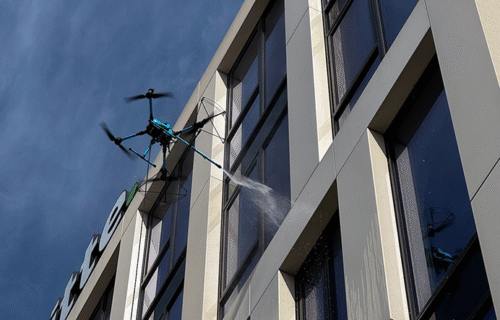The method of cleaning building facades and windows is undergoing significant changes, with drones beginning to replace traditional suspended platforms and chemical-based cleaning solutions. This new approach has the potential to reduce costs by nearly half, improve safety conditions for workers, and lower environmental impact. The trend has started to appear in the Czech Republic, including in historic city areas where commercial buildings owned by Českomoravská Nemovitostní (ČMN), such as Churchill Square and Mezi Vodami, are being cleaned using drone technology.
The cleaning process involves drones spraying demineralized water heated to 70°C, which removes dirt without relying on aggressive chemicals. This method is particularly suitable for historic buildings where chemical cleaning agents could damage delicate plasterwork or building materials.
Petra Vondrová, Senior Property Manager of the Churchill building, noted that her team is always exploring new ways to enhance services. After learning about drone-based cleaning, they decided to test it on the Churchill building due to its large facade surface area. According to Vondrová, the results were positive, with tenants expressing satisfaction and passersby taking an interest in the operation of the drones.
Cost efficiency is one of the main advantages of using drones, as the process requires fewer workers and can be carried out more quickly than traditional methods. Dita Lawn, Senior Property Manager at the Mezi Vodami building, explained that initial reservations about the technology were quickly overcome once they observed its effectiveness and cost benefits, allowing for future investments in other innovations.
Safety is another significant factor influencing the move towards drone cleaning. Traditional methods involving workers suspended at height carry inherent risks, whereas drone operations involve a team of just two individuals—a pilot and a safety technician—reducing potential hazards and associated costs.
Environmental considerations also play a role, especially in historic city areas where maintaining the integrity of building materials is crucial. The absence of harsh chemicals in the drone cleaning process helps prevent damage to facades, making it an appropriate solution for sensitive sites.
Encouraged by the successful pilot cleaning, ČMN plans to implement drone cleaning technology across other properties in its portfolio. CBRE, which also took part in the testing phase, has begun introducing the method in some of its own buildings.
Although drone-based facade cleaning is not yet a standard practice, companies such as ČMN are helping to increase its adoption. The combination of environmental benefits, reduced costs, and improved safety suggests that drone technology could play a larger role in building maintenance in the years to come.
